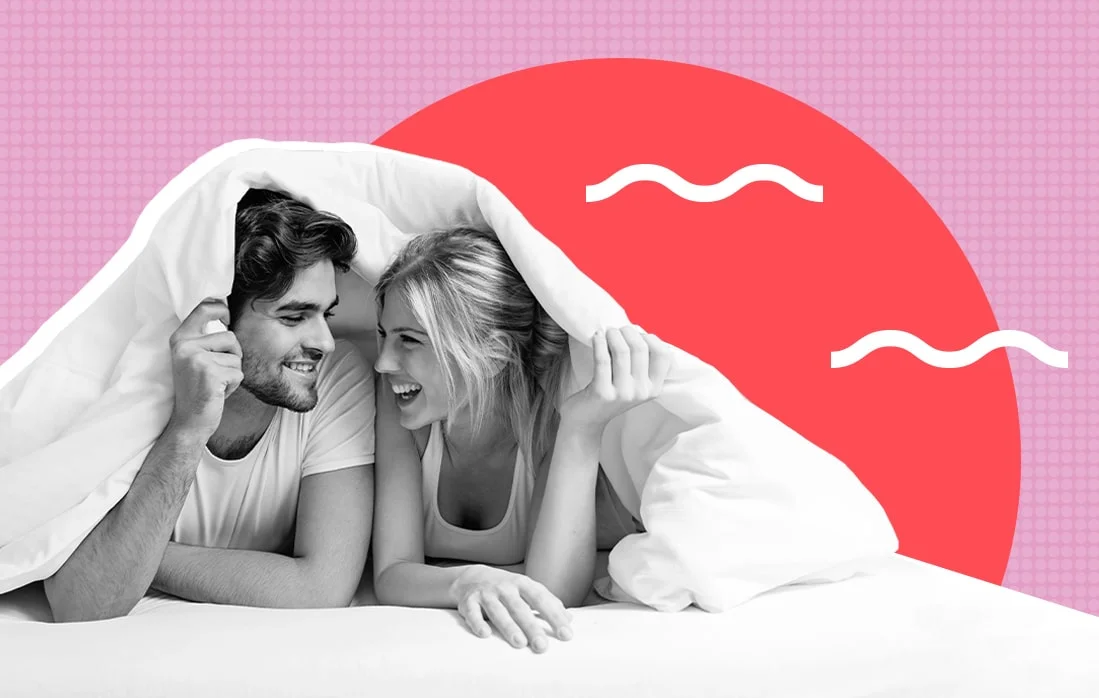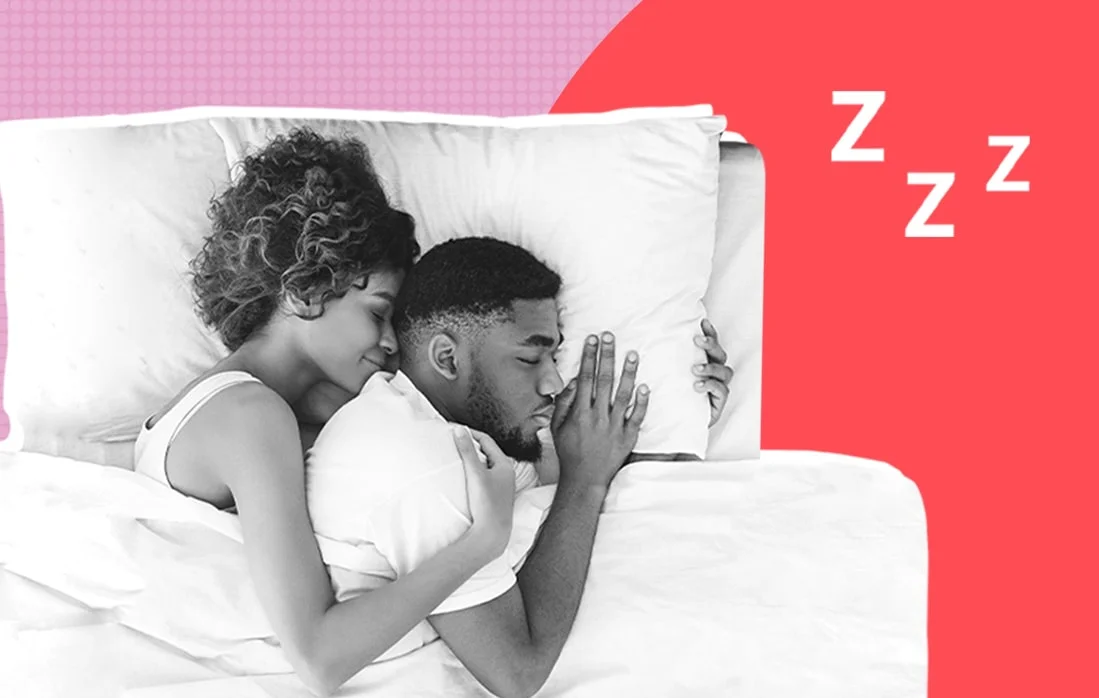
If you sleep with a partner, you’d likely agree it’s not always the ideal environment. Maybe one of you always hogs the comforter, tosses and turns throughout the night, or has to sleep with the TV on — while the other simply can’t. Whatever it may be, we’ve all been there.
But sharing the bed with your loved one isn’t all bad and can actually bring some benefits too. In the spirit of Valentine’s Day, let’s explore some of the hormonally-charged facts that come with sleeping with a partner. I’ve collected my top 5, so Cupid better grab hold of his arrow, because this one’s getting real!
What to Know
Our friends over at Leesa say some cool things can happen hormonally when you’re in bed with your partner (engaging in non-sleep activities) that can actually help you have a more restorative sleep experience. This includes the lovely oxytocin and “smiley” serotonin.
Sleeping with a partner may reduce stress

Oxytocin, a sleep-promoting hormone, often called the “love hormone,” can be released when sleeping with your loved one.
Sex, cuddling, and even holding hands can boost your oxytocin levels. Penn Medicine credits high levels of oxytocin to falling asleep quicker and staying asleep. They not only credit cuddling to give you a boost of oxytocin, but a reduction in cortisol (the stress hormone) – meaning less stress. So whether it’s a PG or R-rated activity, get physical (with your partner’s consent) for the best results in your sleep, health, and relationship!
A Journal of Marriage and Family study published by TIME found that oxytocin release can be paired with a variety of romantic activities, not just sex. The study had some couples play a familiar board game, while others took a painting class. Men experienced the largest increase in oxytocin levels after the art class, and men who played board games actually experienced a dip in oxytocin levels. Women, on the other hand, experienced a slight increase in both activity groups.
Karen Melton, an assistant professor of family and consumer sciences at Baylor University, told TIME that the bonding aspect of the painting class was more to credit than any painting at all. This is because the art activity incited more signs of encouragement from one partner to another, like physical touch.
It could lower your blood pressure
Oxytocin isn’t only great for stress or bonding. According to a report by Johns Hopkins University, oxytocin’s release when “spooning” or cuddling can help you relax and lower your blood pressure. Since oxytocin can naturally promote sleep and lower blood pressure, this is definitely something those already suffering from high blood pressure should keep an eye on! Poor sleep can not only raise your blood pressure and your risk for other cardiovascular concerns, but it can aggravate existing high blood pressure.
It may help women fight against sleep apnea
When sleeping with a partner, women can experience a boost in estrogen, which has been shown to fight against sleep apnea, which is a disorder that can stop your breathing while asleep, according to Yale Medicine. However, menopause will, unfortunately, cancel out that bonus. Low estrogen, often paired with menopause, is a big negative for sleep. So ladies, no matter what stage of life you’re in, hold your partner close for that estrogen boost!
The impact on REM sleep

One bed-sharing study looked at young, healthy, heterosexual couples and studied them both co-sleeping and sleeping individually. The study found 10% more REM sleep, less fragmented REM sleep, and longer undisturbed REM fragments to be associated with co-sleeping. Sleep architectures were also recognized as more synchronized, however, the relationship’s depth played a large role in the level of synchronization.
According to Women’s Health Magazine, the combination of serotonin and dopamine can make you happier. Dopamine is a chemical that connects to the feeling of pleasure. That sounds like a pretty good deal, right?
Well, there’s something else to be said for the relation between serotonin, the “happy chemical,” and REM sleep. Serotonin has long been associated with the experience of sleep, but one Progress in Neurobiology study notes the state of its exact role as controversial. On one hand, it’s believed to help abstain and maintain behavioral sleep, but on the other hand, serotonin is also seen as an inhibitor of REM sleep. Basically, it is inconsistent.
Healthline tends to agree, citing studies showing that an increase of serotonin reduces REM sleep. “Both dopamine and serotonin are involved in your sleep-wake cycle,” Healthline reports. “Dopamine can inhibit norepinephrine, causing you to feel more alert. Serotonin is involved in wakefulness, sleep onset, and preventing REM sleep. It’s also required to produce melatonin.”
So to wrap it up, serotonin from cuddling up with your partner could surely boost your mood, but it won’t provide the best night’s rest.
How your mattress plays a role in partner sleeping

We wouldn’t be Sleepopolis without considering one final aspect of the coupled sleeping dynamic – your bed. It’s a simple fact that everyone is different, and in the case of sleeping with a partner, you’re likely to have a number of differences in what you need or want in a mattress.
As I mentioned above, menopause (the end of a woman’s period) is inevitable. And with menopause comes the side effects of low estrogen, among other things. Women commonly experience hot flashes and night sweats during perimenopause (the span of time leading up to the final end of a woman’s period), which makes the temperature of a mattress quite important. For this stage of life, it’s essential to have a cooling mattress.
There are many other factors for couples that need to be addressed as well. For example, if you have a restless partner, you’ll want a mattress that isolates motion well (so you won’t feel their every move) and has good edge support (so you can utilize the bed’s full area). Other couples may be focused on sex, which will require a mattress with a good level of bounce to really get the endorphins (and oxytocin) flowing nicely.
Whatever it may be – pain, position, or romance – there’s a mattress out there for everyone. It’s your choice whether you want to compromise on a choice that works for both of you, or head to the next level and pick a completely customizable bed for couples (like a Sleep Number). We’ve even compiled a list of the best mattresses for couples.
Before You Head Out
We took the hormonal approach this time around, but there’s even more to learn about your partner and the many factors that go into sleeping together at Sleepopolis.com. Hopefully, this take was an eye-opening experience about how much hormones are at play when sharing the bed (or spending time) with your partner. My advice is to always stay educated, communicate, and listen to your needs as well as your partner’s in order to have the best hormonal response possible. Well, I’m off to an art class with my partner for some much-needed oxytocin release – catch you next time!

























